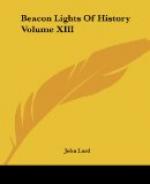The general effect of “Rob Roy,” as well as of “Waverley” and “Old Mortality,” was to make the Scottish Highlanders and Jacobites interesting to English readers of opposite views and feelings, without arousing hostility to the reigning royal family. The Highlanders a hundred years ago were viewed by the English with sentiments nearly similar to those with which the Puritan settlers of New England looked upon the Indians,—at any rate, as freebooters, robbers, and murderers, who were dangerous to civilization; and the severities of the English government toward these lawless clans, both as outlaws and as foes of the Hanoverian succession, were generally condoned by public opinion. Scott succeeded in producing a better feeling among both the conquerors and the conquered. He modified general sentiment by his impartial and liberal views, and allayed prejudices. The Highlanders thenceforth were regarded as a body of men with many interesting traits, and capable of becoming good subjects of the Crown; while their own hatred and contempt of the Lowland Saxon were softened by the many generous and romantic incidents of these tales. Two hitherto hostile races were drawn into neighborly sympathy. Travellers visited the beautiful Highland retreats, and returned with enthusiastic impressions of the country. To no other man does Scotland owe so great a debt of gratitude as to Walter Scott, not only for his poetry and novels, but for showing the admirable traits of a barren country and a fierce population, and contributing to bring them within the realm of civilization. A century or two ago the Highlands of Scotland were peopled by a race in a state of perpetual conflict with civilization, averse to labor, gaining (except such of them as were enrolled in the English Army) a precarious support by plunder, black-mailing, smuggling, and other illegal pursuits. Now they compose a body of hard-working, intelligent, and law-abiding laborers, cultivating farms, raising cattle and sheep, and pursuing the various branches of industry which lead to independence, if not to wealth. The traveller among the Highlanders feels as secure and is made as comfortable as in any part of the island; while revelations of their shrewd intelligence and unsuspected wit, in the stories of Barrie and Crockett, show what a century of Calvinistic theology—as the chief mental stimulant—has done in developing blossoms from that thistle-like stock.




